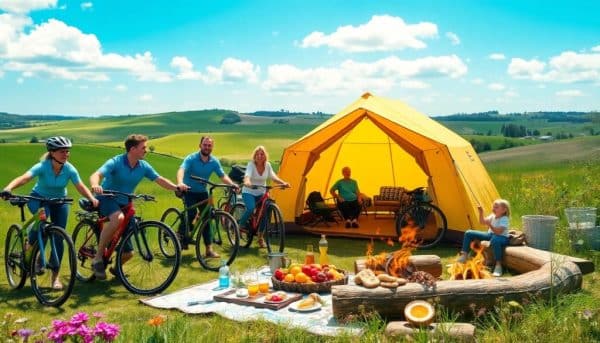Embarking on a cycling and camping journey in the UK is an exhilarating way to explore the breathtaking landscapes and rich history of this beautiful country. Combining cycling with camping allows adventurers to experience the great outdoors while fostering a deeper connection with nature.
This article will guide you through the essential steps to plan your cycling and camping: how to plan a UK adventure, enhancing your experience with tips and insights on gear, routes, and safety.
What is the best time to go cycling and camping in the UK?
The ideal time for cycling and camping in the UK is between April and October. During these months, the weather is generally more favorable, with milder temperatures and longer daylight hours. This allows for extended cycling days and more opportunities to enjoy the outdoors.
However, it’s crucial to consider regional variations in weather. The south tends to be warmer, while northern areas may experience cooler conditions even in summer. Always check local forecasts before setting off to ensure a comfortable experience.
Spring and early summer are particularly beautiful, as wildflowers bloom and wildlife becomes more active. Autumn, with its vibrant foliage, also offers a unique charm but be prepared for unpredictable weather changes.
How to choose the perfect route for your cycling and camping trip?
Selecting the right route for your cycling and camping adventure is vital to ensuring an enjoyable experience. Start by considering your fitness level and the distance you are comfortable covering each day. Planning a cycling adventure should be both challenging and enjoyable.
Resources like Sustrans and Cycle.travel can help you find scenic, well-marked routes that suit your preferences. Look for trails that offer a mix of landscapes, such as hills, forests, and coastlines, to keep your journey interesting.
- Research local maps for specific trails.
- Consider the difficulty and elevation of the route.
- Look for points of interest along the way, such as historical sites or natural wonders.
- Check for available campsites and facilities.
Additionally, seek inspiration from personal experiences or recommendations from fellow cyclists. This can greatly enhance your route-planning process, allowing you to tailor your journey to your interests.
What gear do you need for cycling and camping?
Having the right gear is essential for a successful cycling and camping trip. Your essential bike camping gear should be lightweight, durable, and practical, as you'll be carrying it on your bike.
- Tent: Choose a compact tent that suits your camping style, whether it's solo or group camping.
- Sleeping bag: Opt for a sleeping bag rated for the temperatures you expect to encounter.
- Cooking equipment: A portable stove and lightweight cookware will help you prepare meals on the go.
- Tools and repairs: A basic toolkit for quick fixes on the road, including tire levers, a pump, and a multi-tool.
- Navigation tools: GPS devices or maps are crucial to staying oriented during your adventure.
Don’t forget to pack appropriate clothing and personal items. Layers are key, as they allow you to adapt to changing weather conditions. Being prepared with the right gear can make or break your cycling and camping experience.
How to ensure safety while cycling and camping?
Safety should always be a priority during your cycling and camping adventures. Start by wearing a helmet and visible clothing to ensure you are seen by other road users. Understanding the rules of the road is crucial for a safe journey.
When camping, choose safe locations away from dangerous wildlife and be aware of your surroundings. Familiarize yourself with common animals in the area and how to handle encounters. Always keep food properly stored to avoid attracting wildlife.
- Plan your route to include backup options in case of emergencies.
- Share your itinerary with someone you trust.
- Keep a first-aid kit handy for minor injuries.
Be cautious of weather conditions while out camping. If storms are forecasted, consider seeking shelter or altering your plans. Being proactive about safety can help ensure a smooth adventure.
What are the benefits of wild camping?
Wild camping is a fantastic way to experience nature intimately. It offers numerous benefits, including the opportunity to camp in remote areas away from busy campsites, providing tranquility and a deeper connection to the surroundings.
Sleeping under the stars and having the freedom to choose your camping location are exhilarating aspects of wild camping. Additionally, it allows for spontaneous adventures and the chance to explore less-traveled paths.
- Enhanced privacy: Wild camping often means you're away from other campers, allowing for a more personal experience.
- Unique experiences: Discovering secluded spots can lead to memorable moments not found in traditional campsites.
- Wildlife observation: Being in nature increases your chances of spotting various wildlife in their natural habitat.
However, it’s essential to follow local regulations and guidelines when wild camping to minimize your impact on the environment.
How to plan a successful bikepacking adventure in the UK?
Planning a successful bikepacking adventure involves thorough preparation and flexibility. Start by determining your objectives, whether you're seeking solitude, challenging terrain, or picturesque landscapes. Having clear goals will guide your route selection and gear choices.
Consider incorporating rest days into your itinerary, allowing time to explore local attractions or simply relax. This aspect of planning can greatly enhance your overall experience, making the adventure less about the miles and more about enjoying the journey.
Utilize resources such as Bikepacking Scotland for route inspiration and community advice. Engaging with fellow bikepackers can provide valuable insights into the latest trail conditions, gear recommendations, and safety tips.
Related questions about cycling and camping adventures
What is the 75 rule in cycling?
The 75 rule in cycling refers to the idea that cyclists should aim to maintain a cadence of at least 75 revolutions per minute (RPM) for efficient cycling. This cadence helps optimize energy usage and endurance on long rides, enabling better performance.
Is it illegal to cycle on a path in the UK?
Cycling regulations in the UK vary by location. In general, it is legal to cycle on designated bike paths and tracks. However, cycling on pedestrian footpaths is often prohibited unless specifically marked otherwise. Always check local signage to ensure compliance with the law.
How many km per day is bikepacking?
The distance covered during bikepacking trips can vary significantly based on the terrain and experience level of the cyclist. On average, bikepackers often aim for 50 to 100 km per day. It’s essential to consider your fitness level, the weight of your gear, and the type of terrain when planning your daily distance.
Is 40 too old to start cycling?
No, 40 is definitely not too old to start cycling! Many people take up cycling later in life and find it an excellent way to stay fit and enjoy the outdoors. Cycling is a low-impact activity that can be adapted to suit various fitness levels, making it an ideal exercise for individuals across different age groups.


Leave a Reply